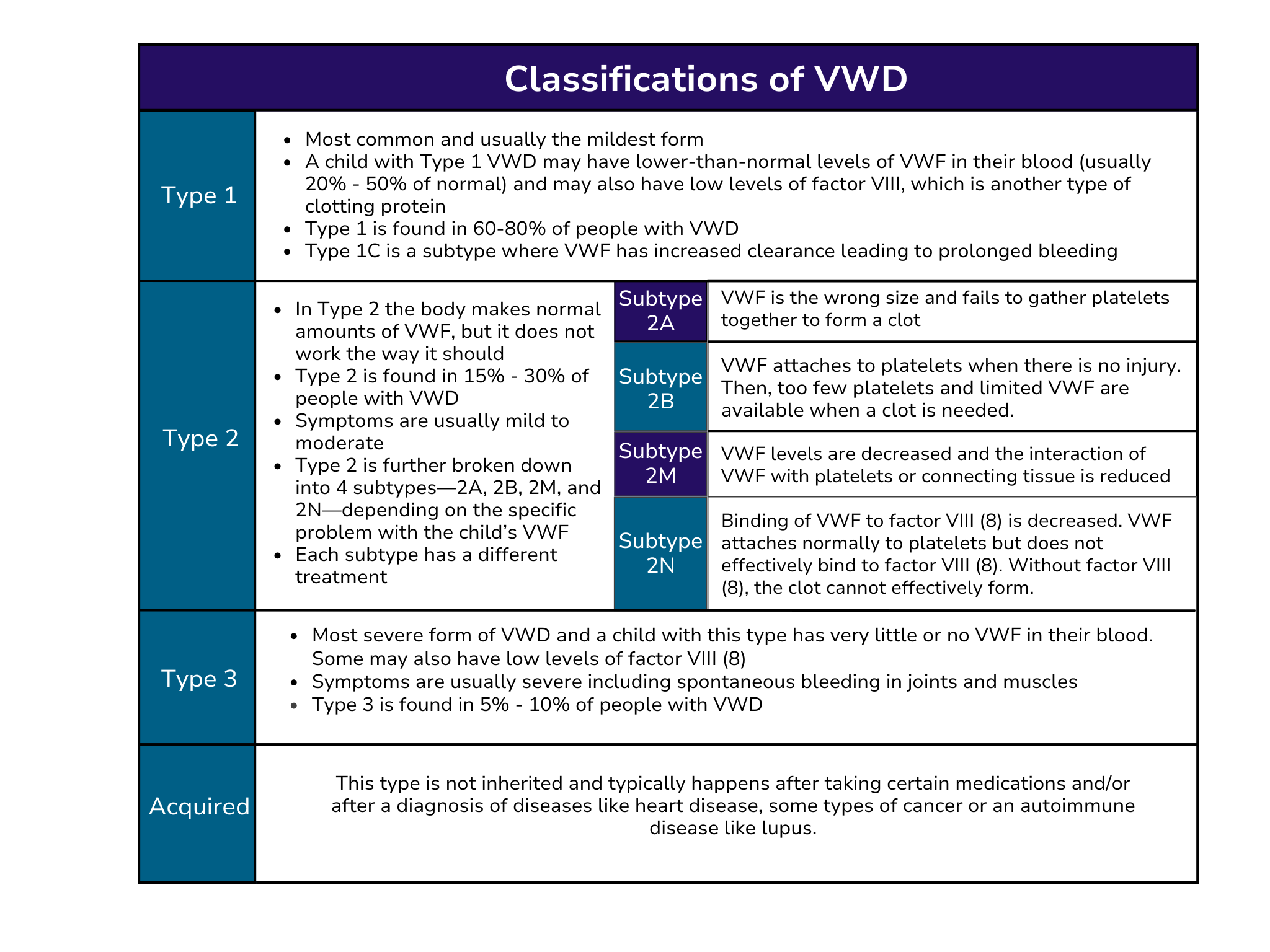Defects in parts of the blood like platelets and clotting proteins can cause the body to be unable to make a proper blood clot. People who have bleeding disorders are unable to form clots, and their bleeding does not stop or continues for longer than it should. Most bleeding disorders are inherited, but sometimes a bleeding disorder can happen spontaneously.
Von Willebrand disease (VWD) is the most common bleeding disorder. A person with VWD is either missing or low in von Willebrand factor (VWF) or they have VWF that doesn’t work properly. Several different types of VWD have been identified, including Type 1, Type 2, and Type 3, as well as subtypes 2A, 2B, 2M, and 2N. In order for a person to be diagnosed with VWD, a combination of blood tests are needed.
This section about VWD includes the following:
What is von Willebrand Disease?
What is von Willebrand Disease?
Von Willebrand disease (VWD) is a bleeding disorder that is caused by a problem with von Willebrand factor (VWF), one of the clotting proteins in the blood. If you have VWD, either you don’t have enough VWF, or your VWF doesn’t work properly.
VWF plays two important roles in blood clotting. It makes platelets stick to the wall of an injured blood vessel, and to each other. Without it, a platelet plug cannot be made, and the bleeding in your body can’t be stopped or takes longer than normal to stop. VWF is also called a carrier protein because it carries one of the clotting factors, factor VIII (8). Without VWF, factor VIII (8) will break down in the bloodstream and there may not be enough of it to stop the bleeding in your body.
VWD is an inherited bleeding disorder, though it can also occur spontaneously (though this is uncommon). VWD is the most common of all inherited bleeding disorders. VWD affects about 1 in every 100 people, or about 1% of the population in the United States. VWD occurs equally for men and women. As an inherited disorder, people with VWD can pass the disorder to their children. There are several different types of VWD.
VWD Symptoms and Diagnosis
If you have VWD, symptoms usually involve the mucous membranes of your body (such as the nose, mouth, stomach, and lungs). It is also possible for you to have joint and muscle bleeds. This type of bleed is more likely if you have a more severe type of VWD. VWD is underdiagnosed because symptoms are often subtle, ignored, or believed to be caused by something else.
The main symptoms of VWD are2:
- Frequent (more than 5 per year) nosebleeds that last longer than 10 minutes
- Bleeding from cuts or injuries that last longer than 10 minutes
- Easy bruising, with bruises that are raised and larger than a quarter
- Being told you are “low in iron” or have been treated for anemia
- Heavy bleeding after surgery, including dental surgery
- Having someone in your family who has one or more of these symptoms
- Having someone in your family who has been diagnosed with a bleeding disorder such as VWD or hemophilia
- For women, girls, and those who have the potential to menstruate:
- Heavy periods (having to change one pad or tampon every hour) or periods that last longer than 7 days
- Heavy bleeding after childbirth or miscarriage
To be diagnosed with VWD, you will need a combination of blood tests. The first type of test is a screening test to see if you have a bleeding disorder. These tests measure the size and types of blood cells, how long it takes for blood to clot, and how well the blood clots1. The results of screening tests may be normal in people with VWD, so additional diagnostic tests are needed. A von Willebrand factor antigen test measures the amount of VWF in the blood. Other tests measure if the VWF works properly, the makeup of VWF, and the amount of factor VIII.
Some of these tests may have to be repeated several times, because your VWF levels can change depending on stress, infections, inflammation, exercise, time of the day, the use of hormone therapy, and pregnancy1. If you have other health conditions like hyperthyroidism, this can affect VWF levels too. Blood samples need to be handled carefully and precisely to receive an accurate diagnosis. The best place for you to get tested and diagnosed for VWD is at a Hemophilia Treatment Center (HTC). There are HTC locations throughout the country.
If you want more information about the location of an HTC nearest to you, please go to the CDC HTC Search Directory.
VWD Guidelines and Resources
In January 2021, new guidelines for the diagnosis and management off VWD came out. These were created in collaborative effort between NBDF, WFH (World Federation of Hemophilia), ASH (The American Society of Hematology) and ISTH (International Society on Thrombosis and Haemostasis). The new recommendations guide the diagnoses and management of VWD and consider best available evidence and the patient perspective.
If you want more information on how to prepare for a visit with your health care provider, please go to How to Prepare.
Finding more resources about VWD:
There are several resources for people with VWD below, including an activity book for children with VWD, summaries for the VWD guidelines, and information about nosebleeds:
1. CDC. (2020, October 26). VWD Diagnosis. Centers for Disease Control and Prevention. https://www.cdc.gov/ncbddd/vwd/diagnosis.html
2. CDC. (2021, April 1). What is von Willebrand Disease? Centers for Disease Control and Prevention. https://www.cdc.gov/ncbddd/vwd/facts.html








